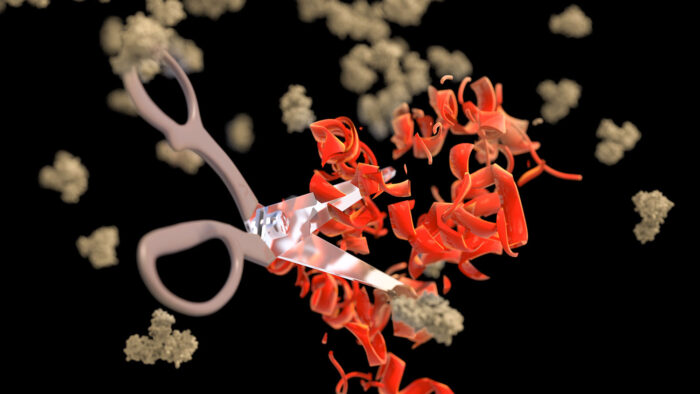Exploitation of the intracellular antibody receptor TRIM21’s mechanism of activation by clustering allows development of new tools for targeted protein degradation

A powerful strategy to study protein function has been to deplete a protein of interest from the cell and then study the consequences on biological processes. Dean Clift from Leo James’ group, in the LMB’s PNAC Division, together with former LMB Group Leader Melina Schuh, previously developed a technology, Trim-Away, that allows rapid depletion of specific proteins using off-the-shelf antibodies. Leo’s group has now exploited new understanding of Trim-Away’s mechanism of activation to expand the technology’s toolbox.
Trim-Away takes advantage of the intracellular antibody receptor TRIM21 and its capacity to target antibody-bound proteins for destruction, due to its role as the last line of defence against invading pathogens. To deplete a specific protein, antibodies against that protein are delivered into cells, either by direct injection or by giving the cells an “electric shock”. The antibodies bind their protein target, are recognised by TRIM21, and then the protein target is destroyed within minutes. However, the mechanism by which TRIM21 triggers degradation has been incompletely understood until recently.
By precisely controlling the number of antibodies bound to a target, and therefore the number of TRIM21 molecules recruited, the team was able to show that degradation is only triggered when a cluster of TRIM21 molecules are bound in close proximity. Indeed, this makes sense in light of other recent work from Leo Kiss, a PhD student with David Neuhaus and Leo James, which showed the precise arrangement needed for creation of the signal to recruit the proteasome.
The team found that TRIM21 clustering is dependent on the nature of the target to which it is recruited. For example, viruses have hundreds of antibody binding sites and can trigger robust TRIM21 activation. In fact, this may explain why TRIM21 evolved this requirement for clustering as anything entering the cell coated with multiple antibodies must require a quick response and degradation. Exploiting this concept, in collaboration with Will McEwan’s group at the UK Dementia Research Institute, the team showed that TRIM21 selectively degrades the mutant form of the protein that causes Huntington’s disease, due to the fact that more TRIM21 molecules can be recruited to the mutant protein, while leaving the normal protein intact.
The finding that clustering of TRIM21 triggers degradation led the team to expand Trim-Away’s toolbox in collaboration with Eurico Morais-de-Sá’s group at the University of Porto. By creating a version of TRIM21 that is fused to a light-sensitive domain called CRY2, they were able to induce TRIM21 clustering just by shining a light on the cells. This then led to degradation of a target protein that was otherwise incapable of bringing multiple TRIM21 molecules together.
With an improved understanding of how TRIM21 is activated and able to recruit the proteasome, Leo’s group have been able to expand Trim-Away’s toolbox. This will enable it to be used to deplete and study the function of more proteins, benefiting research in many diverse fields of biology.
A number of neurodegenerative diseases are caused by the accumulation of abnormally folded proteins in aggregates. Exploitation of TRIM21’s activation by clustering could be useful in treatment of these diseases by directing selective destruction of disease-causing aggregates.
The work was funded by UKRI MRC, Wellcome Trust, Royal Society, Fundação para a Ciência e a Tecnologia, and Norte 2020.
Further references
Target-induced clustering activates Trim-Away of pathogens and proteins. Zeng, J., Santos, AF., Mukadam, AS., Osswald, M., Jacques, DA., Dickson, CF., McLaughlin, SH., Johnson, CM., Kiss, L., Luptak, J., Renner, N., Vaysburd, M., McEwan, WA., Morais-de-Sá, E., Clift, D., James, LC. Nature Structural & Molecular Biology https://doi.org/10.1038/s41594-021-00560-2
Leo’s group page
Will McEwan’s group page
Eurico Morais-de-Sá’s group page
Previous Insights on Research
TRIM21 is both enzyme and substrate when creating a signal to degrade bound viruses and proteins
Trim-Away: powerful new tool for studying protein function